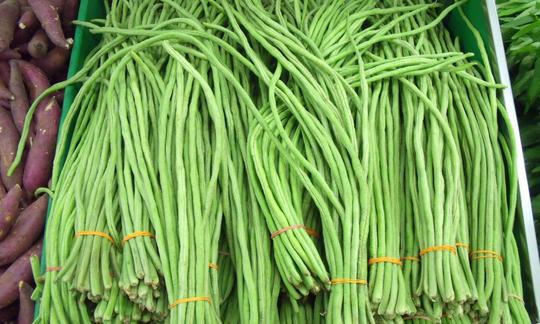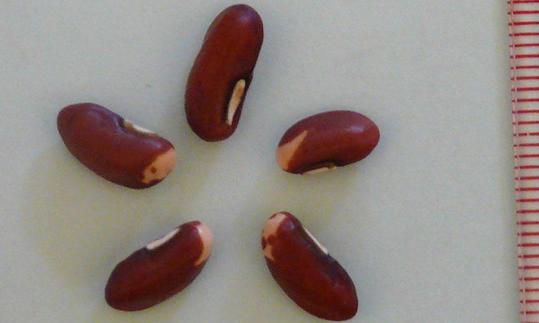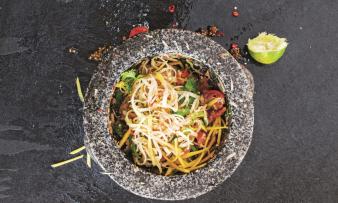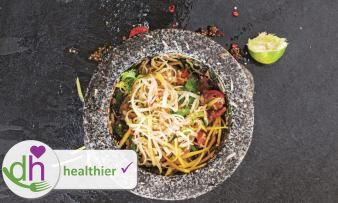Table of contents
The asparagus bean ( Vigna unguiculata ssp. sesquipedalis ), also known as the yard bean due to its long pods, is very closely related to the cowpea . It can be cooked like garden beans, but it can also be eaten raw . Organic quality is preferable.
Use in the kitchen
Asparagus beans are mainly used in the kitchen as a green vegetable. Their striking length of 40 to 50 cm gives them the name "meter beans". For preparation, they are usually shortened by cutting the pods into 4-5 cm long pieces. Their mild, slightly sweet taste is reminiscent of green beans .
In addition to the green asparagus bean described here, there are other varieties (or types and shapes) that differ in length, taste and color. There are short and long varieties as well as deep green, light green and purple varieties. 1 There are small seeds inside the pods. A distinction is made between red and black-seeded yard beans, with the pods with the black bean seeds being preferred for human consumption. 2
Can you eat asparagus beans raw? You can find asparagus beans used as a raw ingredient in Thai and Malaysian salads. 3,4,5 It is important that you do not replace them with the poisonous garden bean when eaten raw. We were unable to find any further information on the tolerable amounts of asparagus beans that can be eaten raw, as they contain anti-nutrients and are therefore not necessarily well tolerated by everyone. More information on this can be found in the chapter "Danger - Intolerances - Side Effects".
How do you prepare asparagus beans? You use asparagus beans when they are green and unripe, by removing the stem ends, washing them and cutting them into shorter pieces. They go well raw in salads with green papaya, tomatoes, carrots, peaches, cucumbers, garlic and coriander leaves, among others. After briefly sautéing, blanching or frying, you can also add asparagus beans to various warm vegetable dishes.
Their pods often end up in wok dishes, such as fried rice or fried noodles . They go well with various other vegetables (e.g. pak choi, goa beans, carrots, spring onions ), mushrooms (e.g. button mushrooms, shiitake mushrooms ) and tofu . Broad beans retain their shape and crunchy texture well when cooked. For stir-fry dishes, the pods are fried together with garlic, ginger, soy sauce and other spices. Stews, soups, salads, casseroles and curries can also be enriched with the crunchy bite of broad beans. In tropical growing areas, the young leaves are prepared like spinach and eaten as a green vegetable. 2
In Nigeria, the ripe black bean seeds, also called akidi, are often dried and cooked as a legume, like raw kidney beans or chickpeas . Due to the antinutrients they contain, they are not edible raw. 6 They can also be soaked in water and sprouted. 2 You can find out more about sprouting under the ingredient mung bean sprouts, sprouted lentils or sprouted buckwheat .
In Asia and Africa, the green pods are often used to make preserves. Broad beans are ideal for pickling. With their crunchy texture and spicy-sour taste, they add a touch of refinement to dishes and are a healthy snack.
Vegan recipe for Chinese asparagus bean salad
Ingredients: 250 g asparagus beans (organic), 1 teaspoon vegetable oil (e.g. rapeseed oil ), 2-3 cloves of garlic, 1-2 chili peppers, 3 cm fresh ginger, 1 teaspoonblack pepper, 3 teaspoons dark soy sauce .
Preparation: Wash the beans and cut into pieces about 5 cm long. Then cook in salted water for 4-5 minutes until al dente. Drain in cold water and place in a bowl. Chop the garlic, ginger and chili peppers. Heat the oil in a wok and fry the chopped garlic, ginger and chili peppers briefly. Add pepper and soy sauce. Mix with the cold yard beans that were set aside and serve the salad. The amount of chili peppers can be varied depending on your tolerance for spiciness.
Vegan recipes with asparagus beans can be found under the note: " Recipes that have the most of this ingredient ".
| Not only vegans or vegetarians should read this: Vegans often eat unhealthily. Avoidable nutritional errors . |
Purchasing - Storage
Asparagus beans are rarely found in European countries. You can sometimes buy them in well-stocked Asian shops and organic supermarkets, such as Alnatura and Denn's Biomarkt . Major retailers such as Migros, Coop, Volg, Edeka, Rewe, Spar, Aldi, Lidl, Denner, Hofer and Billa rarely or never stock asparagus beans in their range, and if they do, then only as special offers.
However, you can buy the seeds of asparagus beans in garden departments or online. You can plant the seeds in a greenhouse and grow your own fresh asparagus beans.
When buying asparagus beans, make sure they are fresh. You can tell that fresh asparagus beans are firm to the touch and have a strong green color, with no signs of wilting or discoloration. You can break the beans slightly to check. Crisp, fresh beans break easily.
In Southeast Asia, asparagus beans can be grown all year round 1 It is a summer plant, which is why the main season takes place mainly during the summer and autumn months, i.e. from June to September . 1,2
The availability of asparagus beans varies depending on the size of the store, catchment area, etc. Our recorded food prices for the DA-CH countries can be found above under the ingredient image - and by clicking you can see their development at various suppliers.
Storage tips
Green, unripe asparagus beans only last a few days in the fridge. After that, they lose their crispness and appear limp. The dried seeds can be kept for over a year in ideal, dry conditions protected from light.
Ingredients - Nutritional values - Calories
Raw asparagus beans contain approximately 90% water, 1 which makes them very low in calories with an energy content of 47 kcal/100g. The macronutrients are divided into 0.4 g fat, 8.4 g carbohydrates and 2.8 g protein. 7
Broad beans contain folic acid in the form of folate (as a folic acid-active substance group): 100 g of the raw pods contain 62 µg of folate, which corresponds to 31% of the daily requirement. A similar amount of folate can be found in artichokes (68 µg/100g) or green peas (65 µg/100g). Raw mung beans (625 µg), borlotti beans (604 µg) and chickpeas (557 µg) are particularly rich sources of folate. Since folic acid is a water-soluble vitamin, a large part is lost during cooking. 7
The vitamin C (ascorbic acid) content of beans is 19 mg/100g. This corresponds to 24% of the daily requirement. Spring onions, beef tomatoes and butternut squash provide the same amount. Sea buckthorn berries (450 mg/100g), black currants (181 mg/100g) and kale (120 mg/100g) provide particularly high levels of vitamin C. 7
Asparagus beans contain 44 mg of magnesium per 100 g, which is 12% of the daily requirement. Lentils (47 mg/100g) and couscous (44 mg/100g) contain a comparable amount. Seeds and nuts are particularly rich sources of magnesium, such as unpeeled hemp seeds (700 mg/100g), linseed (392 mg/100g) and sesame seeds (351 mg/100g). 7
The complete ingredients of asparagus beans (raw), the coverage of the daily requirement and comparison values with other ingredients can be found in our nutrient tables. In the article Nutrients explained you will get a detailed insight into the topic.
Health Effects
Are asparagus beans healthy? A diet rich in beans can reduce the incidence and development of heart disease, obesity and various types of cancer. 8
Beans, including the asparagus bean, contain plenty of soluble and insoluble fiber. Their high fiber content is beneficial for digestion. They contribute to optimal intestinal health by protecting the colon lining, binding harmful compounds in the intestine and facilitating their excretion. 8 Fiber-rich foods also lower blood cholesterol levels by reducing the reabsorption (reuptake) of bile acids. 8,9 You can read more about this inour article on fiber .
In addition, yard beans provide the body with important vitamins and minerals such as folic acid, vitamin C, magnesium and potassium . 7 Potassium has a positive effect on blood pressure and helps regulate hypertension (high blood pressure). This can consequently reduce morbidity and mortality from cardiovascular diseases. 10 Due to the vitamin C they contain, asparagus beans make a valuable contribution as an antioxidant. A sufficient consumption of antioxidant-acting ingredients supports the immune system and the health of blood vessels and can offer protection against cancer. 8
Secondary plant substances
Many of the health effects of asparagus beans can be attributed to the secondary plant substances they contain. Our article on secondary plant substances provides an overview of the classification of substance groups, their occurrence in foods and possible effects on humans.
Asparagus beans contain the following secondary plant substances:
- Isoprenoids: Triterpenes: Saponins (alpha-amyrin, beta-amyrin, cycloartenol); Steroids: Phytosterols (beta-sitosterol, campesterol and stigmasterol); Carotenoids (beta-carotene, zeaxanthin) 13,14,15
- Polyphenols: Phenolic acids: hydroxybenzoic acids (salicylic acid, 4-hydroxybenzoic acid, protocatechuic acid, benzoic acid), hydroxycinnamic acids (4-hydroxycinnamic acid); phenols (pyrogallol), flavonoids: flavanols (catechin, epicatechin, gallocatechin), flavones (baicalein), anthocyanins (delphinidin-3-O-glucoside, cyanidin-3-O-sambubioside, cyanidin-3-O-glucoside, pelargonidin-3-O-glucoside, peonidin-3-O-glucoside) 11,12,14
- Other organic compounds: Hydroxycarboxylic acids (oxalic acid, succinic acid, citric acid, lactic acid, malic acid, aldonic acid) 11
However, it should be noted that the composition of secondary plant substances in asparagus beans can vary depending on the variety, time of harvest and growing conditions. Therefore, quantities are only of limited use and should only be understood roughly.
Numerous studies examine the potential of the seeds in addition to the fruit pods. The seeds also represent a valuable source of secondary plant substances, but their The biochemical composition of the pods depends in part on the sterols (cholesterol, isofucosterol, cycloartenol), the phenol pyrogallol, the saponin cycloartenol 11, as well as alkaloids and tannins, which are only found in the seeds. 6 Unpeeled seeds are preferable, as studies show that they have a higher antioxidant and anti-cancer effect than peeled seeds. This is because the secondary metabolites, such as flavonoids, are mainly found in the seed coat. 11
The pods contain 24 different organic acids and their derivatives, including oxalic acid, succinic acid, citric acid, lactic acid, malic acid and aldonic acid. The functions of the organic acids include regulating the acid-base balance in the body, especially in the digestive tract, and improving digestive processes and the microflora in the large intestine. 11 Among the phenolic compounds in the asparagus bean pods, 4-hydroxycinnamic acid is the most predominant. 11 Phenolic acids have antioxidant, anti-inflammatory, antimicrobial, antimutagenic, hypoglycemic and antiplatelet aggregation, antihyperglycemic, antiapoptotic and antiproliferative properties. 14
The second important group of polyphenols in the yard bean are the flavonoids, which as bioactive compounds also have a variety of pharmacological properties. For example, the catechins, which belong to the flavanols, have capillary-strengthening properties, which supports microcirculation. 11
Anthocyanins, which act as plant pigments in the asparagus bean, have antioxidant, anti-inflammatory, anti-cancer and R-glucosidase-inhibiting (antidiabetic) effects. In addition, the secondary metabolites can reduce the risk of coronary heart disease by protecting the arteries, preventing the formation of blood clots and promoting blood vessel health. 12
The pods contain phytosterols, includingbeta-sitosterol, campesterol and stigmasterol, which are known for their cholesterol-lowering effects. 14,15 These compounds also reduce the risk of cardiovascular disease and have anti-inflammatory and cancer-preventive effects. 15 You can read more about the effects of phytosterols in our article on beta-sitosterol.
It is worth noting that research on the yard bean is limited and has received little attention compared to other legumes. More studies are needed to discover its full potential and positive health effects.
Dangers - Intolerances - Side effects
We are not aware of any allergies to asparagus beans, but people who are sensitive or allergic to legumes should consume them with caution.
Grains and legumes often contain anti-nutritional nutrients (antinutrients) such as trypsin, amylase inhibitors, phytase, oxalates and saponins. These plant substances reduce the bioavailability and bioaccessibility of proteins, enzymes, minerals and trace elements in the digestive tract. 16 In the article Phytic acid or phytate and soaking or sprouting you will learn how to reduce these and what positive effects these substances can have.
Another anti-nutritional plant substance is lectins (also known non-specifically as hemagglutinins or phytohemagglutinins or PHA). A well-known lectin is phasin, which was discovered in the common bean ( Phaseolus vulgaris - hence the name) and is found in high concentrations in closely related bean species. Phasin has been established as a collective term for certain lectins and leads to poisoning when consumed. The information center against poisoning at the University Hospital Bonn ( UKB ) writes about phasin in bean pods and seeds of the common bean that even a few seeds from a bean pod can cause symptoms. Poisoning manifests itself after 2-3 hours in the form of nausea, abdominal pain and vomiting, bloody diarrhea, fever, chills, sweating, seizures and shock. The extent of the symptoms varies greatly from individual to individual. Phasin is a heat-sensitive protein, which is why it can be denatured by cooking. 17
We could not find any confidential information on lectins including phasin and phytic acid in connection with asparagus beans ( Vigna unguiculata ssp. sesquipedalis ) (as of May 2024). However, they do contain oxalates, oligosaccharides such as raffinose and bitter-tasting saponins. 11 The seeds also contain tannins and alkaloids. 6 Oligosaccharides are carbohydrates that do not cause adverse health effects, but lead to gas formation in the intestines after eating beans and thus to unwanted flatulence. 11,18 The flatulence factor can be partially reduced by soaking and cooking. 18
Saponins, on the other hand, have a hemolytic effect: they interact with red blood cells (erythrocytes), causing them to dissolve and consequently leading to anemia. They also inhibit the function of enzymes such as amylase or glucosidase, resulting in digestive disorders of complex molecules and associated health problems. 16 You can read more about saponins under the ingredient quinoa .
Although research does not classify raw asparagus beans as toxic (unlike raw kidney beans, for example, which have particularly high lectin levels 19 ), we recommend keeping raw consumption to a minimum due to the anti-nutrients they contain. We do not have precise information on the effects of large quantities of raw asparagus beans on the digestive tract and the human body.
There are also differing opinions and uncertainty regarding raw consumption of the related cowpea and broad bean seeds . It is assumed that young seeds and pods contain lower amounts of anti-nutrients than mature beans. This is the result of a comparative study on trypsin inhibitors in cowpeas. 20 Nevertheless, studies show that the content of anti-nutrients is subject to considerable fluctuations and, in the case of broad beans, is proven to depend on the variety. 21
In contrast, the following legumes are non-toxic when raw and edible in normal quantities: green peas, sugar snap peas and peanuts .
Ecological Footprint - Animal Welfare
The ecological footprint of a food depends on various factors. The type of agricultural production (conventional vs. organic), seasonal, regional, domestic production or import by truck, ship or plane, different types of packaging and whether the goods are fresh or frozen play a decisive role. 22
Since we were unable to find any figures on the CO 2 footprint of asparagus beans despite extensive research, we show figures for related legumes that require comparable growing conditions: Fresh sugar snap peas have a CO 2 footprint of 0.4 kg CO 2 eq/kg. For green beans, the figure is 0.8 kg CO 2 eq/kg and for dried lentils, 1.2 kg CO 2 eq/kg. 22
The country of origin plays a significant role in calculating the ecological footprint. Local, organic yard beans are preferable, because goods imported from Africa and Asia have to travel a long distance. The resulting transport-related emissions can increase the value of the CO2 footprint. For the ingredient pineapple, we explain the influence of different means of transport such as ships or airplanes on the size of the footprint.
Studies have shown that the yard bean is a particularly resistant plant to heat and drought stress and has a low water requirement. 1, 23 However, we do not have exact figures for the water footprint of asparagus beans, so we give values for comparable legumes: the water footprint of green peas is 595 l/kg and that of runner beans 547 l/kg. For comparison: In general, the water consumption of vegetables is 300 l/kg, grain 1600 l/kg and spices around 7000 l/kg. 24
Legumes, including asparagus beans, make an important contribution to many ecosystems as green manure, but also to agricultural soils. They have nitrogen fixation potential: yard beans form a symbiotic relationship with nodule bacteria, which in turn fix nitrogen from the air and make it available to plants. Thanks to the symbiosis, asparagus beans require little or no nitrogen input to grow. As a result, environmentally harmful nitrogen fertilizers can be avoided during cultivation. 2,23
For detailed explanations of various sustainability indicators (such as ecological footprint, CO2 footprint, water footprint), see our article: What does the ecological footprint mean?
Worldwide occurrence - cultivation
The US Department of Agriculture ( USDA ) states that the asparagus bean originated in South Asia. 2 According to other sources, the asparagus bean was domesticated from the cultivated cowpea ( V. unguiculata ) in Africa. 4,26 It is used primarily as a vegetable in China and South and East Asia. 4
Found in the wild
The cowpea ( Vigna unguiculata ) consists of 13 officially recognized subspecies. 25 These include the two cultivated bean species, the catjang bean ( Vigna unguiculata ssp. cylindrica ) and the asparagus bean ( Vigna unguiculata ssp. sesquipedalis ). Vigna unguiculata ssp. unguiculata is the cultivated cowpea, while the subspecies ssp. dekindtiana and ssp. menensis are related wild forms. 25,26
The pods of the asparagus beans are very similar to those of the common bean . However, the two can be easily distinguished from one another by their length.
There are yard beans with red and black seeds. The red seeds can be confused with kidney beans and adzuki beans. The black asparagus bean seeds can be confused with black beans .
Cultivation - Harvest
The asparagus bean is a fast-growing, annual plant that grows as a twining pole bean or upright as a bush bean: the asparagus bean can be trained upwards using trellises, but without any climbing aid it develops into a bush. 1 It prefers loose soil with a slightly acidic to neutral soil pH value and a sunny location. 2
The asparagus bean is propagated by its seeds. One week after sowing, the seeds begin to germinate. 2 After about 6-10 weeks of seedling growth, blue-violet flowers appear. 2-4 weeks after flowering, numerous flexible pods develop that reach a length of almost one meter. 1 The pencil-thin pods are green or violet in color. Unlike green beans, the asparagus bean prefers temperatures of 27 to 30 °C for growth. 1,2
Growing your own
Asparagus beans can be easily grown in your garden. You can get seeds online or in a garden center. Plant them 2.5-5 cm into the soil. A pot or a raised bed is suitable for this. As it is a heat-loving plant, it needs to be grown in a greenhouse in cooler areas. The ideal time for sowing is late spring temperatures, when the soil has warmed up and the last frost has passed. After planting, the plants should be watered immediately to encourage germination. 2
For optimal growth, a trellis is suitable for the long, climbing plant. The trellis system should be relatively strong to be able to support the height and weight of the metre-long bean. For easy harvesting, it should not be too high, as the plant grows to the top of the trellis. The asparagus bean climbs up on its own, but like tomatoes and peas, it needs a little help. 2
Since the plant can fix nitrogen, it is not necessary to fertilize it. During dry periods, it is advisable to irrigate the beans to maintain a constant bean production. 2
The first pods can be harvested about 2 months after sowing. They are picked when they are unripe, when the seeds are still tender. For long-lasting production, it is advisable to harvest regularly, so that the harvest extends throughout the summer and into the autumn. The plant stops producing flowers as soon as existing beans are allowed to ripen. 2
Further information
The asparagus bean ( Vigna unguiculata ssp. sesquipedalis ) is a legume (Fabaceae). The name sesquipedalis refers to the length: sesqui means "one and a half" and pedalis means "belonging to the foot".
It belongs to the legume genus Vigna, which includes about 100 subtropical species that occur mainly in Africa and Asia. Of these, nine Vigna species have been domesticated, two of them in Africa and seven in Asia. The African Vigna consists of the cowpea ( Vigna unguiculata ) and the Bambara groundnut ( Vigna subterranea ). The Asian Vigna includes the mung bean ( Vigna radiata ), the urd bean ( Vigna mungo ), the moth bean ( Vigna aconitifolia ), the azuki bean ( Vigna angularis ), the rice bean ( Vigna umbellata ) as well as Vigna trilobata and Vigna reflexo-pilosa . 4
Alternative names
Other common names for the asparagus bean are yard bean, cowpea bean, garter bean, knitting needle bean and snake bean. In English it is known as bodi, bora, snake bean, pea bean, judia esparrago, haricot asperge, asparagus bean, yardlong bean (or yard-long bean), long-podded cowpea or Chinese long bean. In Vietnam it is called Taao-hla-chao, in Japan jurokusasagemae, in China dow gauk and in the Philippines sitaw. 2
Black seeds of the yard bean are known in English as kidney pea or black pea. In Nigeria they are called Akidi, Bakin wake, Achishiru and Ewa dudu. 6
Other uses
Mature seeds are often processed into flour. In agriculture, the asparagus bean is used as ground cover or mulch. Young leaves and bean pods are suitable as animal feed for deer, small mammals and birds due to their protein content. The large violet-blue flowers and hanging pods make the asparagus bean a useful ornamental plant in city parks, office buildings, around houses and for greening fences. 2












Comments